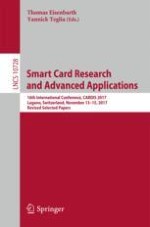2018 | Buch
Smart Card Research and Advanced Applications
16th International Conference, CARDIS 2017, Lugano, Switzerland, November 13–15, 2017, Revised Selected Papers
herausgegeben von: Thomas Eisenbarth, Yannick Teglia
Verlag: Springer International Publishing
Buchreihe : Lecture Notes in Computer Science
